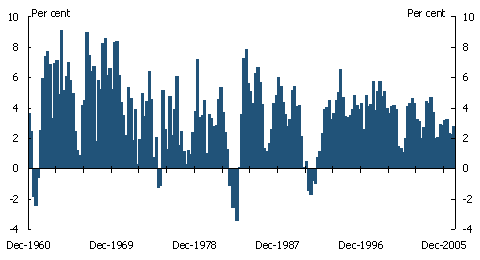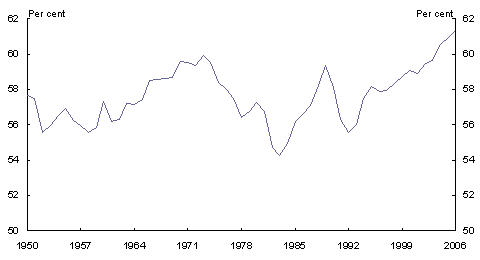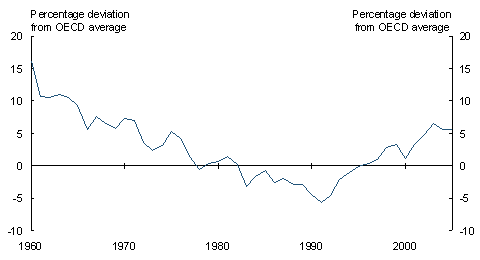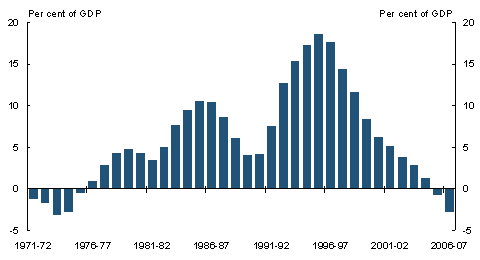Overview
Australia’s strong economic performance with low unemployment, high labour force participation and solid productivity growth reflects the strength of its medium-term macroeconomic frameworks and the Government’s commitment to well-functioning markets.
Reforms since IGR1 have further improved the frameworks to support economic growth and sustainability of government finances, and will help avoid costly burdens being passed on to future generations.
Sustaining economic, social and environmental conditions
The wellbeing of successive generations requires sustainable economic, social and environmental conditions. The Government’s policy framework therefore aims to ensure that economic, social and environmental policies complement each other to bring about improvements in wellbeing.
While wellbeing has a number of elements, sustainable economic growth is an important component, being a major determinant of living standards in society. Steady sustainable growth achieved with low and stable inflation and unemployment is a better outcome than volatile economic conditions. A sound macroeconomic policy framework for monetary and fiscal policy supports these outcomes. In addition, an economy which is flexible and resilient, that adapts readily to changing circumstances — whether opportunities, challenges or unexpected shocks — will be better able to deliver steady economic growth.
A concern for the wellbeing of future generations also needs to take account of social and environmental conditions. Conditions which support and provide opportunities for Australians, for example through employment and investment opportunities, will lead to improvements in wellbeing through time.
Improving wellbeing and achieving sustainable economic growth also requires that appropriate environmental conditions are maintained through time. Natural resources are essential inputs into Australia’s productive capacity, including land, water and other resources. However, economic growth also affects the environment. The sustainability of economic growth can be undermined by poor use of resources or degradation of the environment. More generally, the wellbeing of future generations may be affected by the activities of current generations, if there is loss of productive capacity and/or social amenity from degradation of the environment.
This report focuses on the implications of demographic change for economic growth and then assesses the financial implications of continuing current Government policies over the next four decades. Policy approaches are also discussed. In weighing up the policy options to manage demographic challenges consideration needs to be given to the other forces affecting outcomes, and the interaction of policies.
Macroeconomic policy frameworks
A sustainable fiscal framework is one element of the Government’s broader macroeconomic policy framework, which aims to deliver sustainable economic growth, and contribute to rising employment and higher living standards.
In 1996, the Government implemented a medium-term framework for fiscal policy. This has formed the basis for government fiscal management over the past decade and has delivered sound fiscal outcomes. Key elements include the Charter of Budget Honesty Act1998 (the Charter) and the medium-term fiscal strategy. Both ensure fiscal policy is characterised by a disciplined approach to budgeting, transparent reporting and accountability.
The Charter requires the Government to frame its fiscal strategy having regard to: fiscal risks, including by maintaining Australian general government debt at prudent levels; the state of the economic cycle; the adequacy of national saving; the stability and integrity of the tax system; and the financial effect of policy decisions on future generations.
Consistent with the Charter’s requirements, the Government’s medium-term fiscal strategy is to maintain budget balance, on average, over the course of the economic cycle. Supplementary objectives include maintaining fiscal surpluses over the forward estimates period while economic growth prospects remain sound; not increasing the overall tax burden from its 1996-97 level; and improving the Australian Government net worth position over the medium to longer term.
The Charter also requires the Government to produce, at least every five years, an intergenerational report assessing the long-term sustainability of current Government policies, including by taking account of the financial implications of demographic change. By explicitly showing the long-term fiscal consequences of its policies, the Government has committed to improving its transparency and accountability to the community. The report also is an important tool in monitoring and improving policies and frameworks to facilitate sustainability through time.
Also central to the macroeconomic framework is the inflation targeting regime that aims to achieve Consumer Price Index (CPI) inflation of 2 to 3 per cent per year on average over the course of the economic cycle. The inflation targeting regime was formalised by the Government in August 1996 in a ‘Statement on the Conduct of Monetary Policy’, issued jointly by the Treasurer and the Governor of the Reserve Bank. This statement formalised the Reserve Bank’s operational independence in achieving this goal. It was recently renewed on 18 September 2006 between the Treasurer and the incoming Reserve Bank Governor.
Australia’s economic and fiscal record
The medium-term macroeconomic policy framework, combined with more flexible financial, product and labour markets, has contributed to Australia’s strong economic and fiscal performance over the past decade.
Since the early 1990s recession, Australia has maintained uninterrupted and reasonably stable economic growth (Chart 1.1).
Chart 1.1: Australian real GDP growth, December 1960 to December 2006
(per cent through-the-year)

Source: Australian Bureau of Statistics Cat. No. 5206.0.
Employment growth has been strong, with unemployment falling virtually continuously, from a peak of around 10percent in 1992 to below 5percent currently. Labour force participation rates have been rising, particularly after 2000. As a consequence, the proportion of the population aged 15 and over in employment is at its highest level ever (Chart1.2).
Chart 1.2: Proportion of the population in employment
(People aged 15 and over)

Source: Conference Board and Groningen Growth and Development Centre, Total Economy Database, January 2007.
After averaging around 8per cent per year during the 1980s, inflation has fallen and averaged around 2per cent per year since the early 1990s.
Australia also experienced strong productivity growth in the 1990s, following decades of lagging behind other major developed countries, although productivity growth has slowed somewhat this decade. This productivity performance has underpinned consistent growth in real wages and seen Australian real GDP per person rise more rapidly than the average for OECD countries— a clear contrast to the experience of the previous several decades (Chart 1.3).
Chart 1.3: Australian real GDP per person relative to OECD average

Note: OECD average is calculated for the 24 longest standing OECD member countries.
Source: Conference Board and Groningen Growth and Development Centre, Total Economy Database, January 2007.
Responsible fiscal management supports Australia’s recent economic performance. Over the 10 years to 2005-06, underlying cash surpluses have averaged around 1percent of GDP. These surpluses have contributed to the elimination of Australian Government general government sector net debt for the first time in three decades (Chart1.4).
Chart 1.4: Australian Government general government sector net debt

Note: Data are for the Australian Government general government sector.
Source: Australian Bureau of Statistics Cat. No. 5501.0 and 5513.0, Final Budget Outcomes, 2006-07Mid-Year Economic and Fiscal Outlook, and Treasury estimates.
Economic reforms along with the development of medium-term monetary and fiscal policy frameworks, and the demonstrated commitment to use these frameworks to achieve disciplined monetary and fiscal policy outcomes, have improved Australia’s economic resilience. This is despite sizeable shocks, particularly the 1997-98 Asian financial crisis, the worldwide economic downturn in the early 2000s, and an extended drought beginning in 2002-03.
Policy progress since IGR1
IGR1 raised awareness of demographic pressures and other challenges that Australia is likely to face over the long term and their implications for economic growth and fiscal sustainability. The Government has introduced policy measures to improve the sustainability of economic growth and government finances, and help avoid costly burdens being placed on future generations. Steps taken today reduce the need for larger policy adjustments in the future.
The Government has achieved strong fiscal outcomes since IGR1, delivering budget surpluses totalling over $40billion, eliminating net debt and establishing the Future Fund to fund outstanding Australian Government superannuation liabilities by 2020. Funding the Australian Government’s superannuation liability now will reduce future pressures on the budget at a time when the budget will face the spending challenges associated with an ageing population and other pressures.
The Government has taken steps to address major spending pressures identified in IGR1. Building on the Pharmaceutical Benefits Scheme (PBS) initiatives announced in the 2002-03 Budget, the Government recently announced further reforms to reduce the costs to the Government of medicines while maintaining the price caps to patients. These reforms are estimated to save the PBS $3billion over 10years. They will assist in improving the sustainability of the PBS and create ‘head room’ for financing the provision of new drugs and treatments that emerge in future years.
But IGR1 showed that while population ageing will drive faster growth in government spending in some areas, a key risk to fiscal sustainability also comes from the impact of population ageing on the rate of economic growth. In response, the Government has introduced a range of policies to support economic growth through increased population, participation and productivity.
Higher fertility and higher levels of migration slow the rate of overall ageing of the population. Policy initiatives that have supported this include expansion of the Maternity Payment and other policies to support families, including large increases in the maximum rate of the Family Tax Benefit. The Government also increased the size, and shifted the balance, of Australia’s migration programme. The net migration intake has increased from an average of around 90,000 during the late 1990s to 110,000 over the last ten years. Within this, there also has been a shift in favour of skilled migration, adding to the population of workforce age.
Policies to raise labour force participation help address the slowing of labour force growth associated with an ageing population. The Government has placed particular emphasis on such policies since IGR1. The Welfare to Work package contained a comprehensive package of measures designed to increase incentives to enter the workforce and reduce reliance on welfare. Personal income tax cuts, including cuts in marginal tax rates and increased thresholds, announced in successive budgets, and changes to the Family Tax Benefit also have increased returns to work. Introduction of the mature age worker tax offset and especially the recent superannuation reforms have enhanced work incentives for older age groups.
As labour force growth slows with the ageing population, it will be important to lift productivity to sustain acceptable rates of economic growth. Many of the Government’s policies aim to improve productivity through improving the operation of markets, such as creating a more flexible labour market through the Government’s WorkChoices reforms. Improved links with international markets have been achieved through tariff reductions and trade agreements. Implementation of international standards in areas such as accounting and prudential regulation have improved the cross-border regulation of markets and facilitated competition.
The National Reform Agenda (NRA) announced by the Council of Australian Governments also will contribute to growth in productivity and labour force participation. It aims to build on the gains made by the National Competition Policy agenda. The NRA provides a framework for boosting competition in the areas of transport, energy and infrastructure; reducing the regulatory burden imposed by the three levels of government; and delivering improvements to human capital.